Grant Spotlight | December 17, 2015
Share This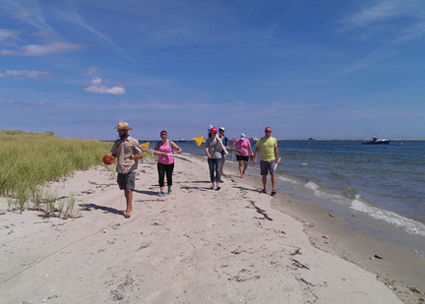 |
Recipient: New England Aquarium - Boston, MA Program: live blue™ Service Initiative Year Awarded: 2013 Web Site: www.neaq.org/index.php
|
Contact: Lace Garland, Manager of Volunteer Program and Internships, New England Aquarium Bradley Pillen, live blue™ Service Coordinator, Grant log numbers: MA-20-13-0288-13
|
Pictured above: Members of the live blueTM Service Corps scan the beach during a project on Tern Island, near Chatham, Massachusetts.
|
“By increasing volunteer engagement in hands-on environmental stewardship, we see enormous potential for increasing civic engagement, building social capital, and developing service leadership. By empowering volunteers with the tools, skills and resources they need to serve as agents of change for the environment, we can promote collective action to protect the blue planet.” – William Spitzer, Ph.D., Vice President, Planning, Programs and Exhibits, New England Aquarium |
Unleashing Local Leaders
Anyone living in the greater Boston area with an interest in protecting our planet’s blue environment need look no further than the New England Aquarium’s live blue™ Service Initiative, which for the past two years has transformed local volunteers into civic leaders and provided hundreds with meaningful service opportunities.
Recognizing the tremendous interest and significant time requirements for the New England Aquarium’s classic Volunteer Corps and internship programs, the live blue™ Service Initiative was launched for those 18 and older to develop personal leadership skills and serve the greater Boston area through unique service projects. Hoping to employ the New England Aquarium’s broad volunteer base, the initiative was also designed to serve Boston’s many environmental organizations.
Mobilizing the Motivated
After completing an hour-long orientation about the New England Aquarium’s conservation and research initiatives, members of the live blue™ Service Corps can immediately sign up for service projects matching their interests and availability. With the help of IMLS grant support, the live blue™ Service Corps has engaged nearly 1,000 volunteers to complete roughly 60 service projects.
Volunteers hoping to take their civic engagement to the next level are also encouraged to apply to become live blue™ Service Leaders who receive extensive training in the basics of volunteer management, partnership building, project design, and troubleshooting. Through a series of four half-day workshops, live blue™ Service Leaders are also briefed on environmental concerns in the greater Boston area. Armed with this training, live blue ™ Service Leaders emerge ready to organize and execute their own volunteer projects.
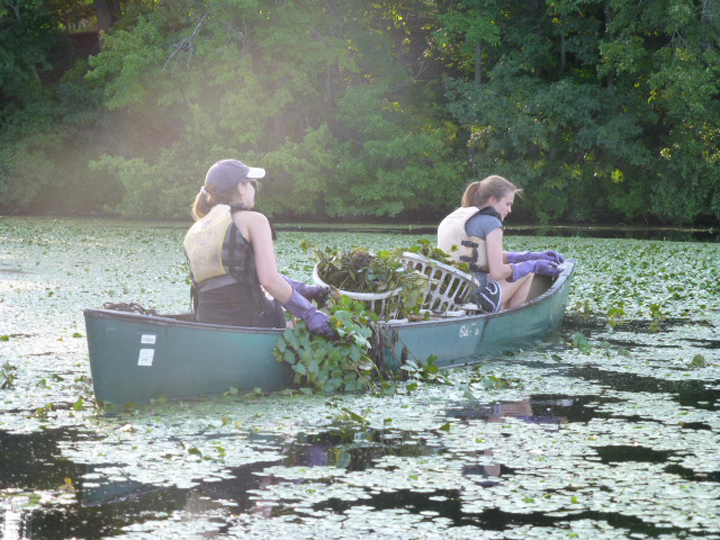
Caption: Two live blue ™ Service Corps members remove invasive water chestnut plants from the Mystic River.
Having completed training cycles for two classes, each containing roughly a dozen live blue™ Service Leaders, New England Aquarium staff have fine-tuned the program’s structure to achieve optimal results for initiative volunteers. After completing the first training cycle, for example, aquarium staff learned that the trainings needed to be condensed into a shorter time span, so that the process from application to designing and delivering projects only took live blue™ Service Leaders six months to complete. Breaking down the training to focus on tangible steps, from the basic idea of project, to the stages of partnership building, helped live blue™ Service Leaders feel less intimidated by the process of designing service projects. Another training takeaway: the best ideas originate in brainstorm sessions where live blue™ Service Leaders collaborate on project concepts together.
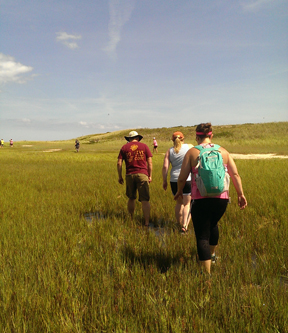
Caption: On Tern Island, volunteers remove fencing that protects the habitat of endangered piping plovers and terns.
As the training evolves for the next cycle of live blue™ Service Leaders, its value remains clear for the live blue™ Service Leaders themselves. One summarized her experience: “I am thoroughly enjoying our class sessions and all of the information that we are getting on the aquarium, service projects, and leadership engagement. I have learned a lot and love being a member of the Service Leader team.”
Planting Partnerships
Collaborating with over a dozen local government and environmental partners, the live blue™ Service Corps provides support for both onetime projects and recurring service opportunities.
One partnership with the Revere, Massachusetts Department of Conservation and Recreation, allows live blue™ Service Corps members to participate in monthly beach clean-ups. Another connects the live blue™ Service Corps with the National Park Service for “Stewardship Saturdays” where volunteers work with park rangers on habitat restoration projects. Smaller organizations also benefit. Grassroots Wildlife Conservation in Concord, Massachusetts, puts volunteers to work restoring Blanding’s turtle habitats at the Great Meadows National Wildlife Refuge.
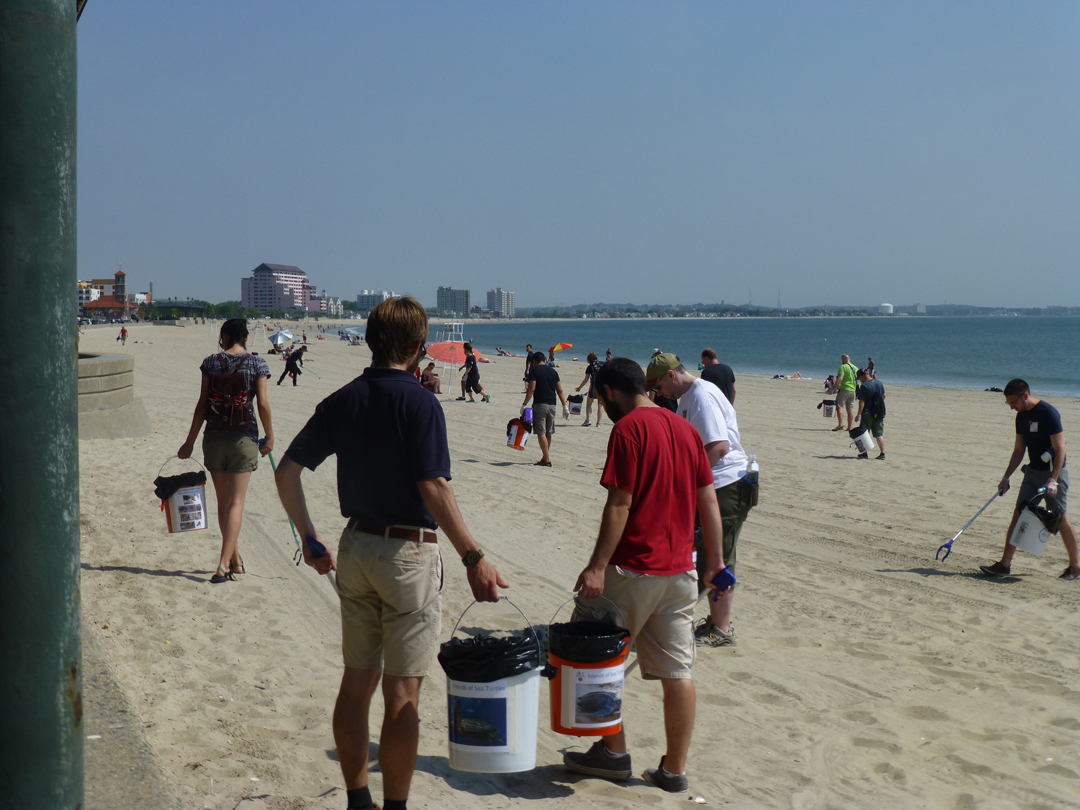
Caption: Members of the live blueTM Service Corps participate in a clean-up at Revere Beach.
The benefits of live blue™ Service Initiative projects extend beyond their immediate impact on the local environment. Storm drain labeling efforts with the Boston Water and Sewer Commission, for example, have educated 110 live blue™ Service Corps volunteers about the public sewer system and water pollution, sparking more sustainable daily habits for volunteers that also reverberate through their families and friends. “We are thrilled to partner with the New England Aquarium live blue™ Service Corps to raise awareness of storm water issues in and around the city of Boston,” said Adriana Cillo, Educational Programs Coordinator, Boston Water and Sewer Commission. “Educating live blue™ volunteers in ways they can help to protect our waterways, and securing their participation in labeling storm drains with the message, ‘Don’t Dump Drains to Boston Harbor,’ will continue to make a difference. This year, volunteers have labeled over 1,100 storm drains in the city of Boston. We look forward to our continued work with the live blue ™ Service Corps to protect Boston’s waterways.”
Whether thinning quahog clam beds at low tide, hand pulling invasive water chestnut plants from a riverbank, or participating in a beach clean-up, the live blue™ Service Corps volunteers and leaders cultivate civic engagement in their communities. Beyond a project’s immediate improvements to the local environment, this work builds social capital by forging stronger ties between citizens and their communities, and inspiring sustainable efforts for generations to come.
A Self-Sustaining Future
With a majority of live blue™ Service Corps volunteers and leaders between 24- and 34-years- old, program creators continue to consider how their efforts can reach new and different audiences. Through broader outreach to the many communities where it could find success, the live blue™ Service Initiative has tremendous potential for expansion and replication.
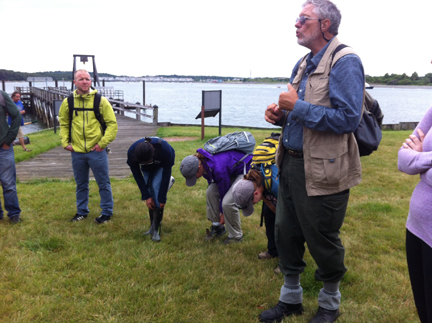
Caption: Volunteers gather at a “Stewardship Saturday” project on Grape Island, in the Boston Harbor Islands.
The Service Initiative is self-sustaining, with 25 trained live blue™ Service Leaders currently designing projects and mobilizing volunteers in the field. Once a service project has been launched, new live blue™ Service Leaders carry it forward, creating a continuous calendar of service opportunities. As more leaders complete training and learn to envision and execute projects, the live blue™ Service Initiative grows, with its success proven in high volunteer return rates across multiple projects. With the goal of engaging thousands of additional volunteers, the sky is the limit for the live blue™ Service Initiative’s capacity to inspire a new generation of environmental leaders.
